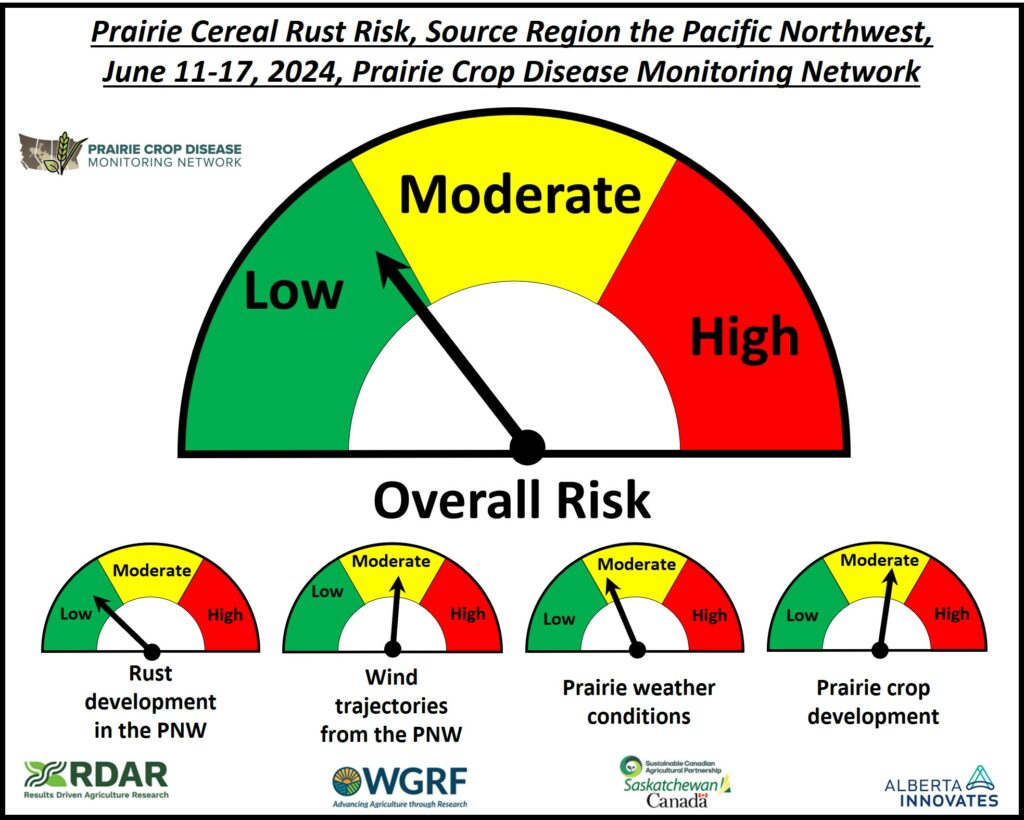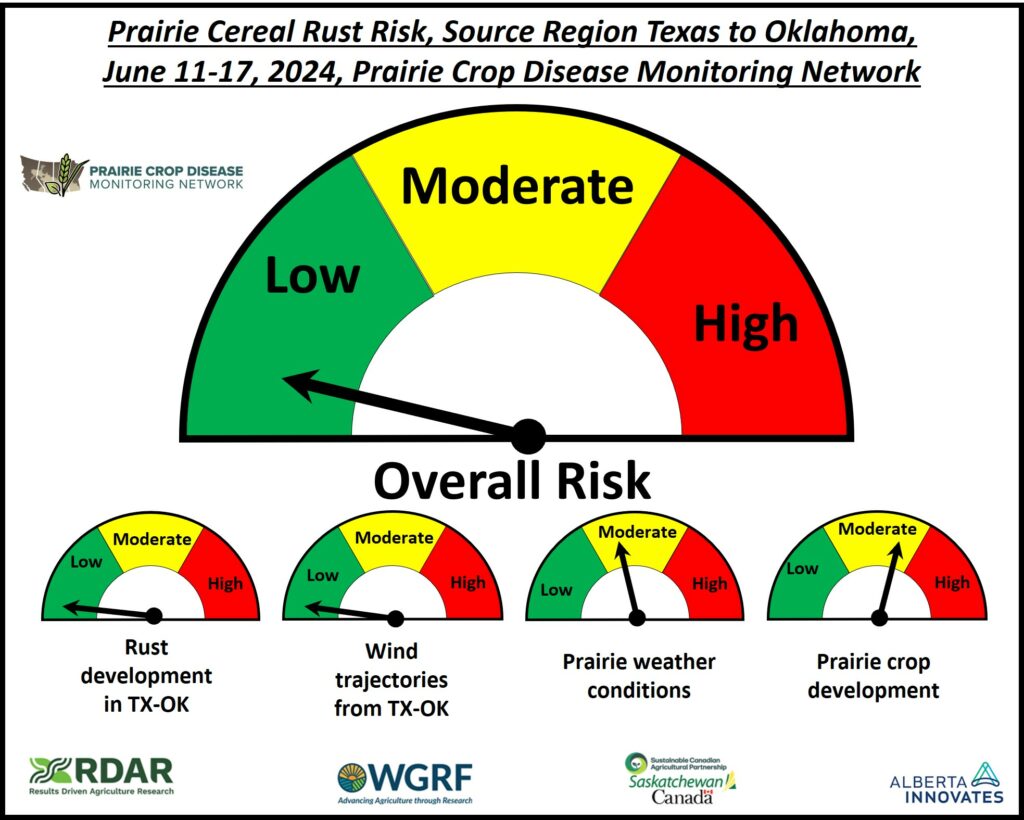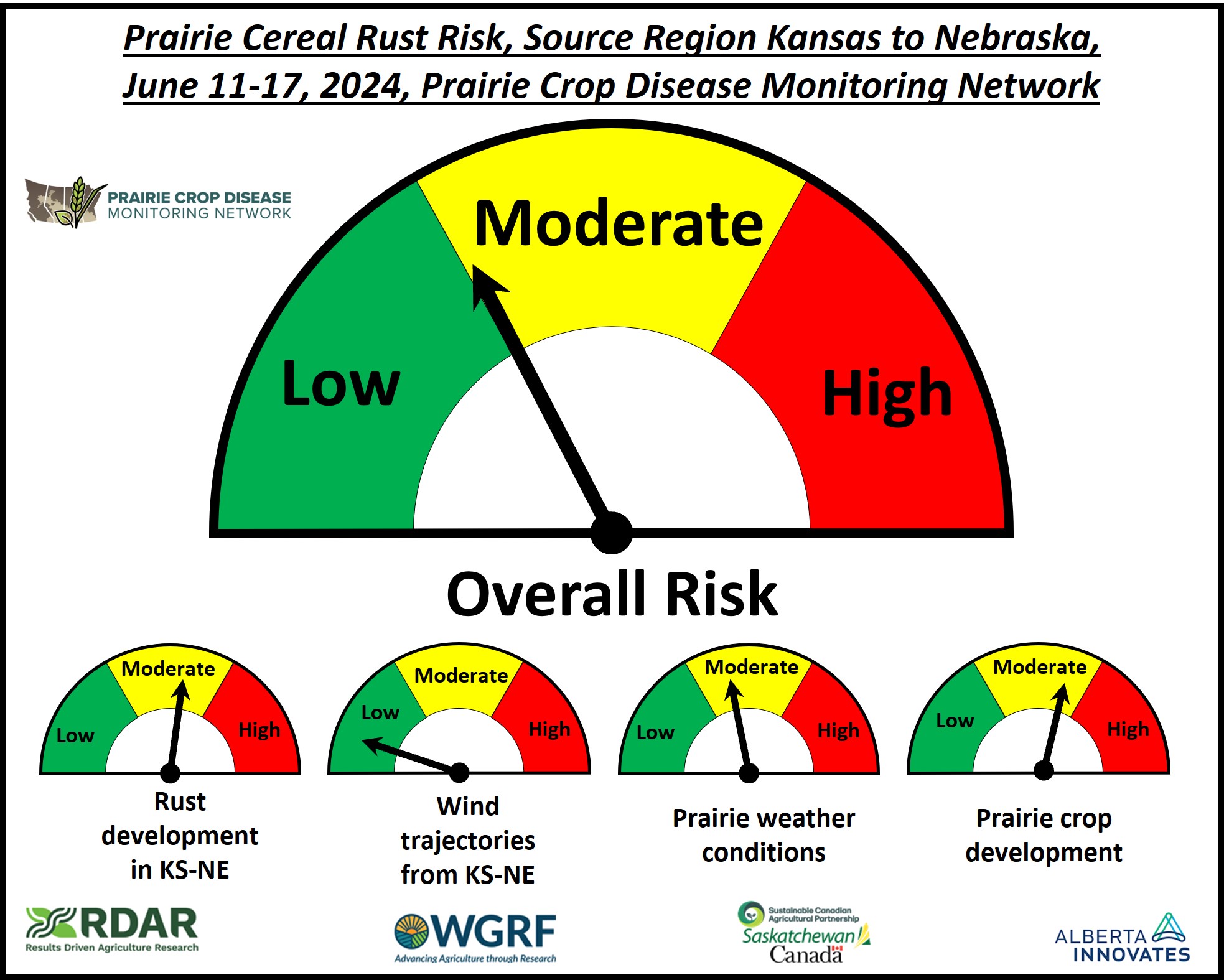The sixth weekly Prairie wind trajectory cereal rust risk report for 2024 is available for download now at the following link: June 11-17, 2024, report.
As of the week of June 11-17, 2024, the overall Prairie cereal rust risk assessment and need for in-crop scouting is as follows:
Pacific Northwest – There were moderate numbers of reverse wind trajectories that passed over the PNW region and into the Prairies, while the most recent reports available indicate that stripe rust development is limited in commercial fields although there are concerns that it could restart in previously sprayed commercial crops. Prairie winter wheat crops are generally progressing from flag leaf emergence through to flowering, while much of the spring wheat crop is at the seedling to tillering stage, with some reports of crops at the flag leaf stage in Manitoba. Rainfall amounts were lowest in southern Alberta, across an area from the Edmonton region to NW Saskatchewan and southwestern Saskatchewan and some areas of east-central southern Saskatchewan. However, areas in central to northcentral and eastern Saskatchewan, western Manitoba and the interlaces and Winnipeg region received more rainfall. Overall, as of June 19, 2024, the risk of stripe rust appearance from the PNW is relatively low and scouting for this disease in the Prairie region as a result of PNW rust inoculum is generally not urgent.

Texas-Oklahoma corridor – There were only four reverse wind trajectories that passed over the TX/OK region and into the Prairies from June 11-17, 2024, while stripe and leaf rust have been previously reported. However, Texas and Kansas winter wheat crops are either mature or will be shortly with harvesting 63 and 83% complete, respectively. As a consequence, winter wheat crops in these regions no longer represent a significant source of rust inoculum for the Prairie region. Prairie winter wheat crops are largely at flag leaf to heading/flowering, while much of the spring wheat crop is in the seedling to tillering stages, although there are reports of Manitoba crops already at flag leaf emergence. Overall, as of June 12, 2024, the risk of stem, leaf, stripe, and crown rust appearance from the Texas-Oklahoma corridor is limited and scouting for these diseases in the Prairie region based on inoculum from TX/OK is not urgent.

Kansas-Nebraska corridor – There were only 14 reverse wind trajectories that passed over the KS/NE region and into the Prairies from June 11-17, 2024, while in May and earlier in June stripe and leaf rust (Kansas) development were reported in commercial winter wheat fields in this region. However, Kansas winter wheat crops are progressing and as of June 16, 2024, 76% of the crop mature, with 8% being harvested in Kansas. As a consequence, the Kansas winter wheat will no longer represent a significant source of rust inoculum, especially over the next 1-2 weeks. The most recent reports from Nebraska (June 14, 2024) indicate that stripe rust is present in all wheat producing areas, with up to severe levels being observed in irrigated fields or where rainfall occurred. Prairie winter wheat crops are generally progressing from flag leaf emergence through to flowering, while much of the spring wheat crop is at the seedling to tillering stage, with some reports of crops at the flag leaf stage in Manitoba. Rainfall amounts were lowest in southern Alberta, across an area from the Edmonton region to NW Saskatchewan and southwestern Saskatchewan and some areas of east-central southern Saskatchewan. However, areas in central to northcentral and eastern Saskatchewan, western Manitoba and the interlaces and Winnipeg region received more rainfall. Rainfall in regions with higher amounts could facilitate deposition of rust spores into cereal crops and subsequent disease development. Overall, as of June 19, 2024, the risk of stem, leaf, stripe, and crown rust appearance from Kansas-Nebraska corridor inoculum is low-moderate and scouting for these diseases in the Prairies is generally not urgent.

The early and widespread appearance of stripe rust in the PNW and KS/NE regions is still concerning, while the recent stripe rust observations from North Dakota, South Dakota, Minnesota and Wisconsin bring the stripe rust issue very close to the Prairies, especially the central to eastern regions. Over the next 1-3 weeks if favourable weather conditions (especially more rainfall) occur in the PNW and Nebraska north to the Canadian border, further rust development could occur. This would result in more rust spores being available to be blown into the Prairie region, as well as more northerly rust development into the Dakotas and Minnesota/Wisconsin.
Potential introduction of plant pathogens to the Canadian Prairies from the USA is a complex process that involves a number of factors. Risk of pathogen introduction can be associated with:
a) occurrence of reverse trajectories that originate over areas known to be associated with elevated levels of plant pathogens,
b) trajectories that occur at low altitudes, and
c) prairie locations are associated with precipitation events when reverse trajectories are passing over.
Between June 11 and June 16 these three conditions were met for fields near Winnipeg and Selkirk, Manitoba. Over a five day interval, reverse trajectories originated from a number of USA source regions that may result in pathogen introduction to prairie crops. The ECCC wind dispersal model predicted that on June 15, 2024 three trajectories passed over the Winnipeg area. These trajectories originated from Oregon, Idaho, Texas, Oklahoma, Kansas and Nebraska. This type of result is rare. In most cases, reverse trajectories originate from one or two of these states prior to crossing the Prairies. Pathogen risk, may increase when trajectories are close to ground level. Reverse trajectories that originated over Texas, Oklahoma, Kansas and Nebraska (blue line) were 500 to 1500 m above ground level and these then passed over the Great Plains and into Manitoba (June 11-15). Lastly, rain totals near Winnipeg were 25 mm (June 15 and 16) and may have resulted in the potential downward movement of pathogens. These results suggest that potential risk of introduction of stripe rust could be high over this past weekend (June 15 and 16, 2024) for the Selkirk/Winnipeg region of Manitoba.
Prairie winter wheat fields are most at risk as they are at the flag leaf to flowering stages. Still, fortunately most current winter wheat varieties have intermediate to high levels of resistance. However, AC Radiant, CDC Buteo, AAC Elevate, Broadview, and CDC Falcon are rated as susceptible (Refer to the Alberta Seed Guide, Saskatchewan Seed Guide, Manitoba Seed Guide). In terms of spring wheat (various classes) and durum the following varieties are either an S or MS: 5700PR, AAC Cameron, AAC Iceberg, AAC Tisdale, AAC Tomkins, AAC Warman, AAC Whitefox, AC Foremost , Cardale, CDC Abound, CDC Adamant, CDC Flare, CDC Pilar, Faller, Prosper, SY Natron, SY Rorke, SY Torach, and Unity. If you are growing a stripe rust susceptible variety, it will be important to keep an eye on your crops for stripe rust especially and follow further PCDMN cereal rust risk reports.

